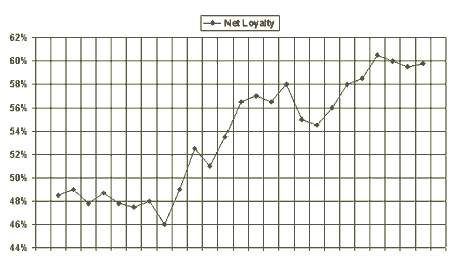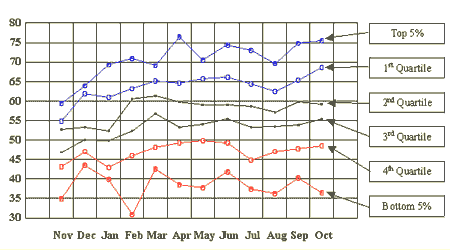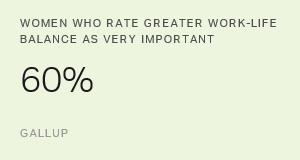"Best practice" call centers focus on six fundamentals for call center management -- getting the right people to be agents and team leaders, paying them for the value they create, and studying top performers for best practices and selection profiles. These centers match their best managers with their best agents, and their managers have the measurement systems needed to motivate their teams.
This business case describes how one client used these processes and procedures to improve its call center performance. The organization was in trouble; it faced declining customer loyalty scores over the past five years and a concurrent slippage in market share.
The challenge: Reverse the trend
Previous research showed the client that customer loyalty, as measured on a survey after a service call, was a key measure in determining future market share. Customer loyalty led market share by approximately 60 days. The Gallup Organization was called in to help reverse this dismal process.
The solution: Use the six fundamentals for call center management to plot a course for change
Chart One below shows customer loyalty scores for the organization before, during, and after changes suggested by Gallup were implemented. The line on Chart Two tracks changes in the percentage of loyal customers after a service call from March 1997 through April 1999. Some notable milestones on Chart Two:
- September 1997: Gallup and the client finished stabilizing the company's measurement system and correcting for inconsistent sample.
- October 1997: Gallup helped the client introduce a pay-for-performance schedule at the customer service representative (CSR) level.
- January 1998: After three months of data collection and analysis, Gallup and the client determined the role of the team manager in CSR performance and introduce a pay-for-performance program for team managers.
- Summer 1998: The percentage of loyal customers after interaction with this CSR workforce continued to rise until summer 1998, when the company announced reorganization plans. The reorganization lasted through August 1998. Following the reorganization, one third of the CSR team managers were no longer with the company. After CSR teams stabilized in August 1998, customer loyalty scores resumed their increase.
Chart One: Business-level Customer Loyalty Scores
 |
The increase in performance tracked on Chart One is impressive. The percentage of loyal customers has increased from approximately 48% at the beginning of the program to 60% in late 1998. However, as impressive as these results are, they hide a deeper insight: individual CSR performance improved during this period of overall increase.
Chart Two tracks results across the same period and displays performance at the individual level. The top line shows the best 5% of individual CSRs from November 1997 through October 1998. These are brilliant performers. They started at 60% customer loyalty rates and drove it up to 76%. Associated with their increase in performance, the CSRs received incremental pay commensurate with the value they created for the organization.
By comparison, look at the bottom line on the chart, which shows the performance of the worst 5% of CSRs during that same time period. These CSRs dealt with the same customers under the same circumstances as the top 5% of CSRs. Yet they made no progress in improving their customer loyalty scores. They started 25 percentage points lower than the best 5%, and at the end of the year they were 40 percentage points behind the best CSRs. It begs the question - what's the difference between the top 5% and the bottom 5% of CSRs? Two reasons: The bottom 5% of CSRs do not have the talent to perform the job, and they are members of poorly managed teams.
Chart Two: Individual CSR Customer Loyalty Scores
 |
How can performance of this CSR workforce improve even more? From this chart, the answer is clear. The bottom quartile of CSRs, as represented by the bottom two lines, need to find some other line of employment. These CSRs do not have the talent to be successful. In contrast, the top quartile of CSRs, represented by the top two lines on the chart, should set the standard for the entire workforce. Top-quartile CSRs should be studied to determine the necessary talents and processes for achievement of superior results. Managers should be evaluated in the same ways.
Once a talent profile for CSRs and team managers has been developed, profile is created for new hires. Similarly, once a company determines what great managers and CSRs do, those processes should be the basis for CSR and manager training and development in quartile two and three (the third and fourth lines on Chart Two).
In the end . . .
There are significant and measurable rewards associated with managing a CSR workforce to maximum performance. Top-quartile CSRs and managers are much more valuable to an organization than are bottom-quartile performers. The management challenge is straightforward: increase the performance of the entire workforce to top-quartile standards. The strategies are equally clear: integrate the six fundamentals of effective call center management into your call center's management culture.
To read the first article in this series, see "Best Practices -- An Overview" in the "See Also" area on this page.
